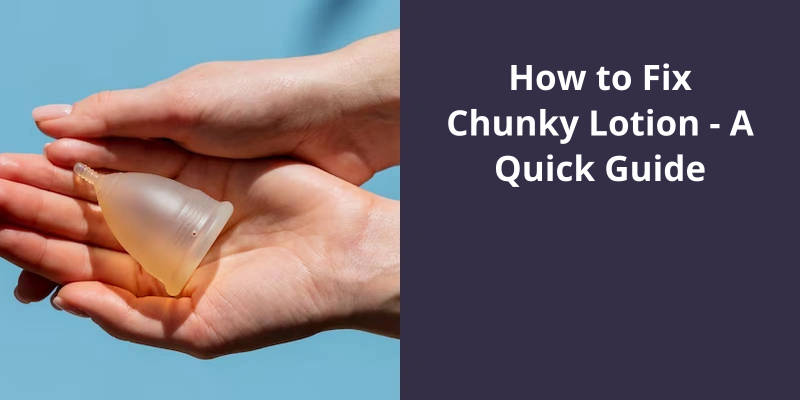Have you ever opened up your favorite lotion only to find that it’s turned into a clumpy, chunky mess? It can be incredibly frustrating to spend your hard-earned money on a product that no longer works the way it should. But fear not! So, say goodbye to chunky lotion and hello to silky, hydrated skin once again!

Can You Fix Lotion That Has Separated?
Have you ever encountered the frustrating situation of discovering that your once smooth and creamy lotion has transformed into a chunky mess? Fear not, for there’s a solution to salvage your beloved skincare product! Separation in lotion can occur due to various factors, such as the addition of too much water or the absence of sufficient emulsifier. But worry not, as fixing chunky lotion is a relatively simple process that can be accomplished with a few easy steps.
The first step in fixing chunky lotion is to gently heat it. This can be done by utilizing a double boiler, which involves placing your lotion container in a larger pot filled with hot water. Heat the water, gradually increasing the temperature until your lotion becomes hot, but not scalding.
Once your lotion is heated, it’s time to address it’s separation issue. The most effective way to do this is by adding a small amount of extra emulsifier to the mixture. Popular emulsifiers like Polawax or E-Wax are suitable options. Start by pouring a small amount of the extra emulsifier into the warmed lotion and stir vigorously. The goal is to dissolve the emulsifier completely, ensuring that it blends seamlessly with the other ingredients.
This process might take a few minutes, but be patient, as it’s crucial for achieving a smooth and homogeneous consistency. Once the emulsifier has dissolved completely, observe your lotions texture. If it’s transformed into a smooth and velvety consistency, congratulations!
If, however, your lotion is still exhibiting signs of separation, don’t be disheartened. Repeat the heating and emulsifying process, ensuring that you’re gentle yet thorough in your efforts. It’s essential to pay attention to the proportions and ratios of your emulsifier, as adding too much can result in a greasy or sticky texture, while too little may lead to further separation. Finding the right balance is crucial for achieving the desired outcome.
Adding water to thick lotion can be a simple and effective way to achieve the desired consistency. However, it’s important to use distilled water when thinning out store-bought body lotion.
Can I Add Water to Thick Lotion?
Distilled water is free from impurities and minerals, making it the safest option for adding to your chunky lotion. Begin by pouring a small amount of distilled water into a clean container. It’s important to keep track of how much water youre adding, as adding too much can drastically affect the consistency and effectiveness of the lotion.
Next, slowly pour the lotion into the container with the water, stirring gently as you go. This ensures that the water is evenly distributed throughout the lotion. It’s important to be patient and add the lotion gradually to avoid creating a watery or runny consistency.
You may notice that the lotion becomes smoother and thinner as you stir. If it’s still too thick for your liking, you can add a little more water, but be cautious not to overdo it.
As a general rule, it’s best to add water in small increments to avoid ruining the lotions texture. It’s also worth noting that adding water may dilute the scent and potentially shorten the lotions shelf life.
Once youve achieved your desired consistency, transfer the thinned lotion back into it’s original container or a clean, airtight jar. Make sure to label it with the date and the fact that it’s been thinned for future reference.
Adding water, specifically distilled water, is an effective way to fix chunky lotion. Remember to store the thinned lotion properly and use it within a reasonable timeframe.
Source: How to make a thick skin cream thinner without losing … – Quora
Phase separation, also known as the splitting of water and oil in a lotion, can be a frustrating experience. Not only does it affect the appearance of your carefully crafted product, but it also raises questions about it’s stability. Understanding the reasons behind this curdling phenomenon is crucial to preventing future mishaps and ensuring a perfect lotion consistency.
Why Did My Lotion Curdle?
Why did my lotion curdle? If your emulsion isnt stable, then over time you may start to see the water and oil splitting away from each other again. This process is called phase separation and means that your beautiful lotion now looks like a complete mess. There are several reasons why this may happen. One possibility is that you didnt properly emulsify the ingredients together. Emulsification is the process of blending the water and oil phases together so that they form a stable mixture. If this step isn’t done correctly, the water and oil may separate over time, resulting in a chunky lotion. Another possibility is that the emulsifier you used isnt strong enough to keep the water and oil phases together. Different emulsifiers have different strengths, and some may not be suitable for certain formulations. Additionally, if the lotion is exposed to extreme temperatures or is stored in an environment with high humidity, it can affect the stability of the emulsion and lead to phase separation. Furthermore, certain ingredients, such as botanical extracts or essential oils, can also destabilize the emulsion and cause the lotion to curdle. Finally, it’s important to consider the quality and freshness of the ingredients you use in your lotion. Using expired or low-quality ingredients can impact the stability of the emulsion and result in a curdled product. Overall, to fix your chunky lotion, you’ll need to re-emulsify the mixture. This can be done by gently heating the lotion and blending it again, using a high-speed mixer or immersion blender. Additionally, you may need to add a stronger emulsifier or adjust the formulation to improve stability. It’s also a good idea to store the lotion in appropriate containers and avoid exposing it to extreme temperatures or humidity. Lastly, make sure to use fresh, quality ingredients and properly emulsify the lotion to prevent curdling in the future.
Common Emulsifiers Used in Lotion Making and Their Strengths
When it comes to fixing chunky lotion, understanding the common emulsifiers used in lotion making and their strengths is essential. Emulsifiers are ingredients that help bind the water and oil phases in a lotion together, ensuring a smooth and consistent texture.
Some commonly used emulsifiers include:
- Cetyl Alcohol: This emulsifying wax is great for creating thick and creamy lotions. It provides excellent stability and moisturizing properties.
- Glyceryl Stearate: A popular choice for emulsifying lotions, glyceryl stearate offers good stability and a luxurious feel. It helps reduce the greasiness of oils while providing a silky texture.
- Emulsifying Wax NF: This emulsifier is a blend of various ingredients, making it suitable for a wide range of formulations. It provides stable emulsions and can handle higher oil concentrations.
- Lecithin: Derived from soybeans or eggs, lecithin acts as a natural emulsifier. It offers good stability and moisturizing properties, but may require additional ingredients to create a stable lotion.
- Polysorbate 80: Often used in combination with other emulsifiers, polysorbate 80 helps solubilize oils in water-based formulations. It improves stability and enhances the overall texture of the lotion.
Each emulsifier has it’s unique strengths, so choosing the right one for your formulation is crucial. Consider factors like desired texture, stability requirements, and the type and concentration of oils used. By understanding these common emulsifiers and their strengths, you can effectively fix chunky lotion and achieve a smooth, well-emulsified product.
Applying beauty products can be a delightful ritual, but experiencing pilling can quickly dampen the experience. To keep lotion from pilling, it’s essential to consider a few key factors. By allocating adequate time for application, selecting complementing formulas, exfoliating your skin, avoiding excessive product application, and using a damp applicator, you can bid farewell to pilling woes. Let’s delve into these tips further.
How Do You Keep Lotion From Pilling?
When it comes to skincare, we all want products that deliver on their promises and leave our skin feeling smooth and nourished. However, sometimes our favorite lotions can turn chunky and start pilling on our skin, which can be frustrating and make our skincare routine less effective. If youve been dealing with this issue, worry not, because we’ve some top tips to help you fix chunky lotion once and for all.
One important factor to consider when applying beauty products is the amount of time you spend on the application. Rushing through the process can’t only lead to uneven product distribution but also contribute to pilling. Take your time and massage the lotion into your skin thoroughly. This will help the product absorb better and reduce the likelihood of it pilling.
Another aspect to consider is the combination of products you use. Sometimes, certain ingredients in your lotion may not work well with other skincare products youve been using. To avoid pilling, choose formulas that complement each other. For example, if youre using a water-based serum, opt for a moisturizer with similar consistency to avoid any clashing textures.
Exfoliating your skin regularly can also help prevent lotion pilling. By removing dead skin cells and unclogging pores, you create a smoother canvas for the product to be absorbed into. This can eliminate any potential friction that could cause pilling.
Applying too much product can also be a common mistake that leads to pilling. By using more than what your skin can handle, you risk overwhelming it and causing the excess product to pill. Stick to the recommended amount and adjust if needed, keeping in mind that less is often more when it comes to skincare.
Lastly, using a damp applicator can make a significant difference in preventing lotion from pilling. Whether it’s a brush, sponge, or even your fingers, dampening them slightly before applying the product can help create a smooth application and reduce friction. This, in turn, can minimize the chances of pilling.
Fixing chunky lotion and preventing pilling requires attention to detail and a mindful skincare routine. Taking the time to properly apply your beauty products, choosing complementary formulas, exfoliating regularly, not over-applying, and using a damp applicator can all contribute to a smoother, pill-free experience. Remember, skincare is a personalized journey, so don’t hesitate to experiment with different techniques and products until you find what works best for your skin.
Understanding the Science Behind Lotion Pilling: Exploring the Causes and Mechanisms Behind Lotion Pilling Can Help Individuals Better Understand How to Prevent It.
- Understanding the Science Behind Lotion Pilling: Exploring the causes and mechanisms behind lotion pilling can help individuals better understand how to prevent it.
As much as we rely on lotions to keep our skin hydrated and smooth, time can take a toll on their effectiveness. When you notice liquid seeping out or encounter a lumpy, cottage cheese-like texture, it’s a clear indication that your moisturizing product has reached it’s expiration date and is no longer able to provide the desired benefits. It’s crucial to recognize these signs and consider replacing the lotion to ensure your skin receives the care it deserves.
Why Does My Lotion Look Like Cottage Cheese?
When you consistently find your lotion resembling cottage cheese, it’s crucial to understand the underlying reasons for this discouraging occurrence. There are a few common culprits that can cause your lotion to take on this undesirable appearance. One of the primary factors is the presence of bacteria or mold growth within the product. This can result from the introduction of foreign contaminants, improper storage, or the expiration of the lotion itself.
Another reason for the chunky consistency in your lotion may be the separation of it’s ingredients. Lotion typically consists of a water phase and an oil phase, which need to be properly emulsified to maintain a smooth texture. If the emulsion breaks, the two phases can separate, leading to a cottage-cheese-like appearance. This can be caused by temperature changes, freezing, or exposure to air.
Furthermore, texture issues may arise if the lotions composition is compromised. Over time, certain ingredients can degrade or lose their effectiveness, leading to the formation of clumps or lumps. Additionally, excessive exposure to heat or sunlight can damage the lotion, altering it’s consistency and rendering it ineffective.
To address the problem of chunky lotion, it’s important to first assess it’s quality and expiration date. If the lotion is past it’s expiration date or has an unpleasant odor, it’s best to dispose of it properly and replace it with a new one.
Start by stirring the lotion gently with a clean spoon or spatula to redistribute it’s ingredients. If this doesn’t resolve the issue, try warming the lotion slightly by placing the bottle in a warm water bath, ensuring the cap is tightly sealed to prevent water from entering. After a few minutes, remove the lotion from the water bath and shake it vigorously to encourage the ingredients to mix together once again.
How to Properly Store Lotion to Prevent Bacteria and Mold Growth
Lotion can sometimes become chunky due to the growth of bacteria and mold. To prevent this, it’s important to store your lotion properly. Here are a few tips:
1. Keep your lotion in a cool, dry place away from direct sunlight. Heat and humidity can promote the growth of bacteria and mold.
2. Make sure the lid or cap of the lotion bottle is tightly closed after each use. This will help to prevent air and moisture from entering the bottle, which can lead to bacterial and mold growth.
3. Avoid using your fingers directly in the lotion container. Instead, use a clean spoon or spatula to scoop out the desired amount of lotion. This will help prevent contamination with bacteria from your hands.
4. If you notice any changes in color, texture, or smell of your lotion, discard it immediately. These can be signs of bacterial or mold growth.
By following these storage tips, you can help extend the shelf life of your lotion and prevent it from becoming chunky due to bacteria and mold growth.
It’s important to note that when lotion appears chunky, it could be a sign of product instability. This typically occurs when the oil- and water- soluble chemicals start to separate, resulting in an unusual thickness or grainy texture. Detecting these changes early on can help determine the effectiveness and shelf life of the product.
What Does It Mean When Lotion Is Chunky?
When your lotion appears chunky, it generally indicates a loss of product stability. It’s important to understand that lotions are made up of both oil- and water-soluble ingredients. These ingredients work in harmony to provide moisture and nourishment to your skin. However, when the oil and water separate, it leads to the formation of chunks or a grainy texture.
One reason could be the expiration of the product. Over time, lotions can break down, causing the ingredients to separate. Exposure to extreme temperatures or improper storage can also impact the consistency of your lotion. Hence, it’s crucial to store your lotion in a cool, dry place away from direct sunlight.
Firstly, you can try shaking the bottle vigorously to encourage the oil and water to mix back together. If this doesn’t work, you can use a clean spoon or spatula to stir the lotion gently, combining the separated components. Be careful not to introduce any contaminants into the product while doing so.
Another option to fix chunky lotion is to warm it up. Place the bottle in a bowl of warm water and let it sit for a few minutes. The heat will help soften the lotion, making it easier to mix and returning it to it’s original consistency. However, avoid using excessive heat, as it can alter the quality of the product.
In some cases, chunky or grainy lotion may be beyond repair. If your efforts to reintegrate the ingredients are unsuccessful or if the lotion has an off smell or strange texture, it’s best to discard it. Using compromised or unstable products on your skin may lead to irritation or other adverse reactions. Therefore, it’s important to pay attention to the texture and consistency of your lotions to ensure they provide you with the desired benefits.
Conclusion
In conclusion, understanding how to fix chunky lotion is an essential skill for any skincare enthusiast or DIY beauty enthusiast. By following the quick and easy guide provided, you can rescue your favorite lotion from it’s undesirable state and restore it to it’s smooth and creamy texture. Whether the cause is temperature changes, expired ingredients, or improper storage, the solutions presented in this guide offer simple yet effective remedies. By incorporating the suggested methods, such as heating, stirring, filtering, or diluting, you can salvage your chunky lotion and continue to enjoy it’s moisturizing benefits without wasting any product. Remember to always check the expiration date and store your lotions properly to prevent future occurrences of chunkiness.





